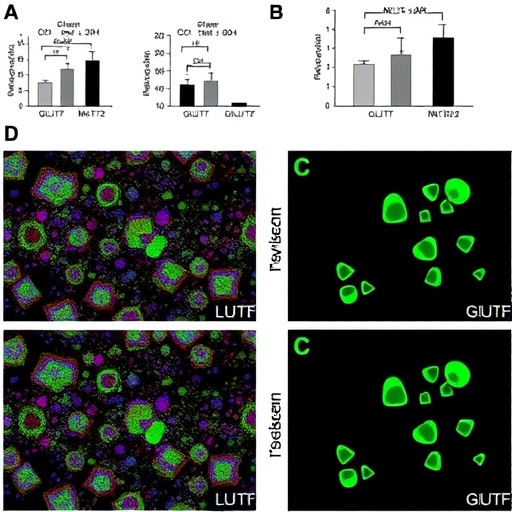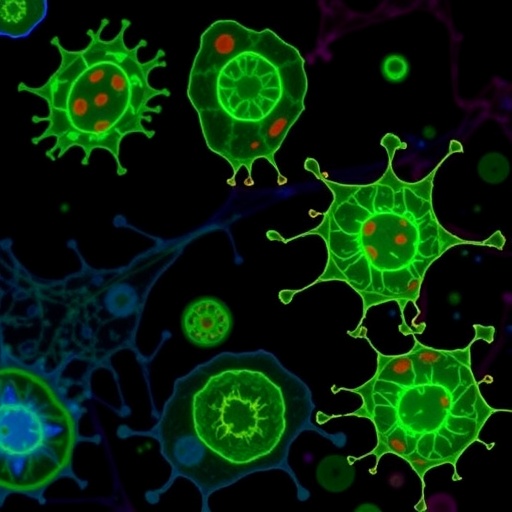In the ongoing battle against renal cell carcinoma (RCC), a groundbreaking study has illuminated new molecular intricacies that could revolutionize therapeutic strategies. Scientists have uncovered a pivotal role of the circular RNA circ_001024 in modulating RCC progression through its competitive interaction with microRNA miR-145-3p, ultimately regulating the fructose transporter protein GLUT5. This discovery opens avenues for targeted interventions that disrupt this molecular crosstalk, potentially halting the aggressive spread of RCC.
Circular RNAs (circRNAs) have recently emerged as critical players in cancer biology, serving not merely as byproducts of splicing but as active regulators of gene expression. Their unique closed-loop structure endows them with remarkable stability, allowing them to act as molecular sponges that sequester microRNAs (miRNAs), thus indirectly influencing protein translation. This latest research focuses on one such circRNA, circ_001024—previously obscure yet now found to be highly overexpressed in RCC tumors.
Delving deep into circ_001024’s architecture, researchers employed Sanger sequencing complemented by RNase R digestion assays to validate its circular nature. Actinomycin D treatment further confirmed its resilience and prolonged half-life compared to linear counterparts. The robust presence of circ_001024 within RCC cells, primarily localized in the cytoplasm as revealed by Fluorescence in situ Hybridization (FISH), hints at its functional engagement in post-transcriptional gene regulatory mechanisms.
A series of quantitative real-time PCR experiments demonstrated significantly elevated levels of circ_001024 in tumor samples relative to adjacent normal tissue. Functional assays revealed that enforcing circ_001024 expression stimulated RCC cell proliferation, migration, and invasion—hallmarks of cancer aggressiveness. Conversely, targeted knockdown attenuated these malignant properties, suggesting a causative role of circ_001024 in facilitating tumor progression.
The mechanistic underpinnings became clearer with bioinformatics analyses pinpointing miR-145-3p as a potential interacting miRNA. Confirmatory dual-luciferase reporter assays elucidated a reciprocal binding relationship: circ_001024 acts as a miRNA “sponge,” competitively inhibiting miR-145-3p. This microRNA, known for tumor-suppressive functions, typically represses a set of oncogenic targets, including the GLUT5 protein—a key facilitator in cellular fructose uptake.
Subsequent RNA pull-down assays and rescue experiments cemented the axis of circ_001024, miR-145-3p, and GLUT5 in RCC pathophysiology. Overexpressing miR-145-3p partially reversed the oncogenic effects driven by circ_001024, corroborating that circ_001024’s malignant influence is mediated through miR-145-3p sequestration. Western blot analyses further revealed GLUT5 protein levels mirroring circ_001024 expression, linking enhanced fructose metabolism to RCC advancement.
Intriguingly, clinicopathological correlation studies depicted GLUT5 expression as significantly associated with the WHO/ISUP grading of RCC tumors—a critical determinant of malignancy and prognosis. This association, however, did not extend to patient age, gender, tumor size, or TNM staging, underscoring GLUT5’s potential role as a biomarker for tumor aggressiveness rather than tumor burden.
These revelations underscore a novel metabolic regulatory mechanism in RCC, where circ_001024 modulates the metabolic landscape through GLUT5 by titrating miR-145-3p availability. The study situates metabolic adaptation at the nexus of RCC progression, highlighting fructose metabolism as a previously underappreciated contributor to renal carcinogenesis.
Beyond the molecular implications, the translational potential of these findings is vast. Therapeutically targeting circ_001024—either by disrupting its miRNA-binding capacity or by enhancing miR-145-3p function—could impair GLUT5-mediated metabolic pathways, potentially starving RCC cells of vital nutrients required for rapid growth and invasiveness.
Moreover, the study’s advanced methodological framework combines transcriptomic validations, functional perturbations, and clinical data integration—establishing a robust template for future circRNA investigations in cancer biology. These comprehensive approaches ensure that the observed effects are not artifacts but reflect genuine biological processes relevant to tumor progression.
As RCC remains notoriously resistant to conventional therapies, the identification of circ_001024 and its interactive network with miR-145-3p and GLUT5 offers fresh hope. It invites a paradigm shift towards targeting RNA-based regulatory circuits and metabolic dependencies in cancer, a strategy that may eventually translate into personalized and more effective treatment modalities.
In conclusion, this pioneering work unravels the sophisticated endogenous competition between circRNAs and miRNAs in RCC, highlighting circ_001024’s role as a molecular decoy that subverts miR-145-3p suppression of GLUT5. This intricate regulatory mechanism not only advances our understanding of RCC pathogenesis but also charts a promising course for future research and therapeutic innovation.
Subject of Research:
The regulatory role of circ_001024 in renal cell carcinoma progression via competitive binding to miR-145-3p and consequent modulation of GLUT5.
Article Title:
Role and mechanism of circ_001024 endogenous competition for miR-145-3p targeting to regulate GLUT5 in RCC
Article References:
Zhao, L., Xu, J., Li, D. et al. Role and mechanism of circ_001024 endogenous competition for miR-145-3p targeting to regulate GLUT5 in RCC. BMC Cancer 25, 1713 (2025). https://doi.org/10.1186/s12885-025-14878-3
Image Credits: Scienmag.com
DOI:
05 November 2025
Keywords:
Renal cell carcinoma, circular RNA, circ_001024, miR-145-3p, GLUT5, fructose metabolism, tumor progression, RNA sponging, molecular oncology
Tags: cancer biology and gene expressioncircular RNA circ_001024circular RNA stability and functioncompetitive endogenous RNAsGLUT5 regulation in cancermicroRNA miR-145-3p interactionmolecular mechanisms in RCCrenal cell carcinoma progressionRNA sequencing in cancer researchrole of circRNAs in tumorstargeted cancer therapiestherapeutic strategies against RCC





